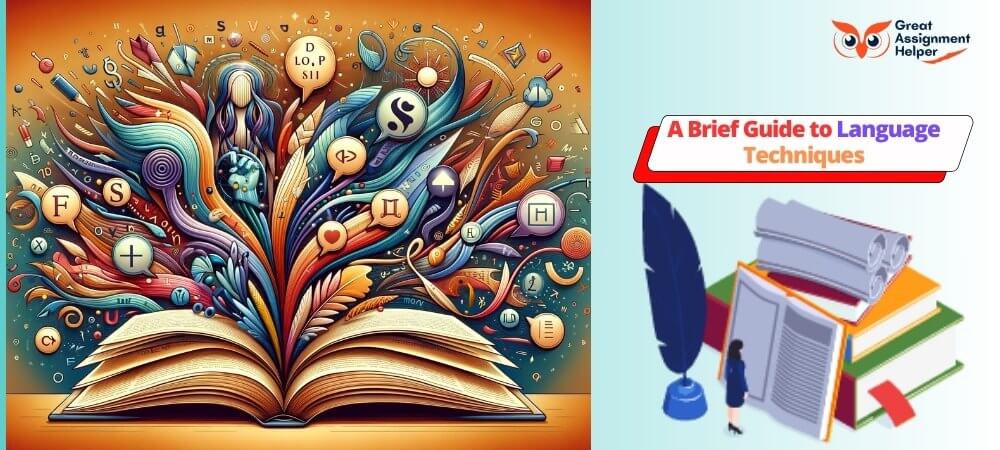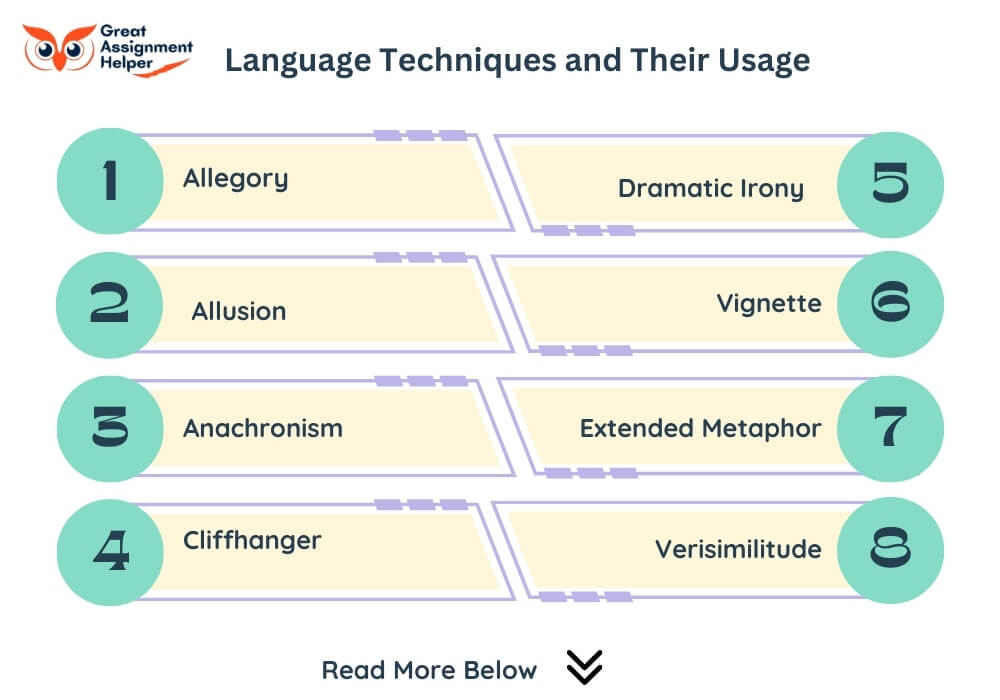
Listen To This Blog
Introduction
In the vibrant world of writing, the mastery of language techniques stands as a cornerstone for crafting compelling narratives and persuasive content. These techniques are not just tools in a writer's arsenal; they are the very threads that weave the tapestry of effective communication. Whether it's to captivate, convince, or convey profound ideas, understanding and utilizing these techniques can significantly elevate the quality of writing. From the subtle art of metaphor to the impactful use of irony, each technique opens a new avenue for expression. As we delve into this guide, we'll explore various language techniques that can transform ordinary writing into an extraordinary experience, enriching both the writer's skill and the reader's journey.
What are Language Techniques?
Language techniques are the diverse and dynamic tools used by writers and communicators to enhance the effectiveness of their language. These techniques encompass a range of strategies, from the use of vivid imagery and metaphors to the strategic placement of irony and satire. They serve as the building blocks for creating rich, engaging, and persuasive content. By skillfully employing these techniques, writers can convey complex ideas, evoke emotions, and connect with their audience on a deeper level. Understanding and mastering these techniques is crucial for anyone looking to refine their communication skills and leave a lasting impact through their words.
Language Techniques and Their Usage

In the diverse landscape of writing, language techniques are employed across various genres, each serving a unique purpose. These techniques are the essence of crafting narratives that resonate with readers. They range from allegory, which unravels complex ideas, to metaphors that draw vivid comparisons, enhancing the reader's understanding and engagement. The artful use of irony can add depth, while a well-placed simile can illuminate a concept with clarity. For writers aspiring to enrich their work, grasping these techniques is key. They not only embellish the text but also empower the writer to communicate more effectively, making each word and phrase impactful and meaningful.
Allegory
Allegory is a powerful literary device where characters, events, or settings symbolize deeper meanings, often conveying moral, social, or political messages. It allows writers to explore complex ideas subtly, presenting them through metaphorical narratives. This technique enriches storytelling, offering layers of interpretation and inviting readers to delve beyond the surface story.
Allusion
Allusion is a subtle yet powerful language technique where writers reference historical, cultural, or literary elements to enrich their narratives. This technique weaves depth into the text, allowing readers to draw connections and insights. By invoking familiar concepts, allusion enhances the reader's engagement, adding layers of meaning to the writing.
Anachronism
Anachronism in writing is a creative tool where elements from different time periods are combined, often leading to intriguing contrasts. This technique can add a layer of humor, highlight historical discrepancies, or simply serve to engage the reader's imagination by blending past and present in an unexpected way.
Cliffhanger
A cliffhanger is a masterful narrative technique, often employed to keep readers on the edge of their seats. It involves ending a story or a chapter at a suspenseful moment, leaving the audience eagerly anticipating what comes next. This technique is a powerful tool in storytelling, creating a compelling urge to continue reading and discover the unfolding mysteries.
Dramatic Irony
Dramatic irony is a powerful literary device where the audience knows more about a situation than the characters within the story. This technique creates a heightened sense of suspense and curiosity, as readers watch characters navigate scenarios with an unawareness that adds depth and emotional complexity to the narrative.
Vignette
A vignette in writing is a brief, evocative description, episode, or character sketch. It's a powerful tool that paints a vivid picture in the reader's mind, often capturing a moment or giving depth to a larger narrative. These concise, imagery-rich snapshots are instrumental in adding emotional resonance and nuanced layers to storytelling.
Extended Metaphor
An extended metaphor is a literary device where a metaphor, a comparison between two unlike things, is expanded upon over several lines or throughout a work. This technique delves deeper into the comparison, allowing the writer to develop more intricate and layered meanings, enriching the narrative and enhancing the reader's engagement and understanding. It's a powerful tool for adding depth and dimension to writing.
Verisimilitude
Verisimilitude is a pivotal element in storytelling, where the narrative is crafted to appear incredibly lifelike and believable. This technique breathes authenticity into fiction, allowing readers to immerse themselves fully in the created world. It bridges the gap between reality and imagination, making the story's events and characters resonate with a sense of realness and plausibility.
Foreshadowing
Foreshadowing is a subtle yet powerful literary device, where hints or clues are woven into the narrative, suggesting future events or outcomes. This technique builds anticipation and curiosity, keeping readers engaged as they try to piece together the puzzle. Skillfully executed, foreshadowing enriches the storytelling experience, adding layers of depth and intrigue to the plot.
Symbolism
Symbolism in writing is a powerful technique where symbols are used to represent deeper meanings and concepts. Beyond their literal interpretation, these symbols resonate with additional significance, often evoking emotional responses or reflecting underlying themes. Whether it's an object, a character, or a setting, symbolism enriches the narrative, adding layers of depth and insight, and inviting readers to delve into a more profound understanding of the text.
Humour in Writing
Humour in writing is a powerful tool that transcends mere entertainment. It's a crafty technique that can bridge gaps, lighten complex topics, and connect with audiences on a human level. Skillfully woven into narratives, humour can transform the tone, making content more relatable and memorable for readers.
Suspense
Suspense in writing is a crafted tension that grips the reader's attention. It's the art of weaving uncertainty and anticipation into the narrative, keeping the audience on the edge of their seats. Skillfully used, suspense builds an emotional connection, driving the reader's curiosity and engagement with the unfolding story.
Imagery
Imagery is a powerful language technique that paints vivid pictures in the reader's mind, transcending mere words on a page. It involves using descriptive language that appeals to the senses, crafting scenes that readers can see, feel, hear, and even taste, thereby enriching the narrative and enhancing emotional resonance.
Irony and Situational Irony
Irony is a literary device where words convey a meaning opposite to their literal sense. Situational irony, a subset, occurs when the actual outcome of a situation contradicts expectations. Both forms add depth and humor to writing, often leading to thought-provoking and memorable moments.
Analogy, Metaphor, and Simile
Analogy, metaphor, and simile are foundational language techniques that enrich writing with vivid imagery and comparisons. An analogy draws parallels between different ideas, enhancing understanding. Metaphors imply deeper meanings, subtly linking unrelated concepts. Similes, using 'like' or 'as', make direct comparisons, painting clear and relatable pictures in the reader's mind.
Satire
Satire stands as a sharp tool in the writer's kit, blending humor with critique to spotlight societal and political issues. It's a clever dance of wit and insight, where irony and exaggeration converge to challenge norms and provoke thought. Skillfully executed, satire not only entertains but also sparks meaningful dialogue and reflection.
Motif in Writing
A motif in literature is a recurring element - be it an image, phrase, or symbol - that holds significant thematic weight. It echoes throughout the narrative, reinforcing core ideas and lending depth to the story. Skillfully woven, motifs create a tapestry of meaning, enriching the reader's experience.
Motif Vs. Symbol
In literature, a motif is a recurring element - be it an image, phrase, or action - that reinforces the theme. Symbols, on the other hand, are objects or figures that stand for broader concepts or ideas. While motifs contribute to the narrative's atmosphere and depth, symbols often carry a wider, sometimes universal, significance beyond the immediate story. Both enrich the reading experience by adding layers of meaning.
Personification
Personification breathes life into inanimate objects and abstract ideas by bestowing them with human qualities. This technique infuses writing with depth and emotion, allowing readers to form a more personal connection with the narrative. Through personification, the non-human elements of a story can express feelings, thoughts, or actions, enriching the overall storytelling experience.
Paradox
A paradox is a fascinating language technique that intertwines contradictory elements to reveal a deeper truth. It challenges conventional thinking, compelling readers to explore beyond surface meanings. Skillfully used, paradoxes can add a layer of intrigue and depth to writing, sparking thoughtful reflection and engaging the audience in a unique way.
Oxymoron
An oxymoron is a fascinating language technique where contradictory terms are combined to create a unique, thought-provoking concept. It blends opposing ideas, like 'deafening silence' or 'bittersweet', to evoke deeper understanding and intrigue. This stylistic device adds a layer of complexity and richness to the text, enhancing its expressive power.
Conclusion
In conclusion, the exploration of language techniques offers a pathway to enhancing one's writing skills, crucial for anyone engaged in crafting compelling content. These techniques are not just tools but are integral to the art of effective communication in various forms of writing. For individuals seeking to refine their skills further, seeking English assignment help can be immensely beneficial. Services like GreatAssignmentHelper provide online assignment help, offering guidance and insights into the application of these techniques. Their expertise can aid in understanding the nuances of language, ensuring that your writing not only meets academic standards but also resonates with your intended audience. Embracing these techniques with the support of professional services can elevate your writing, making it more engaging, persuasive, and impactful.

